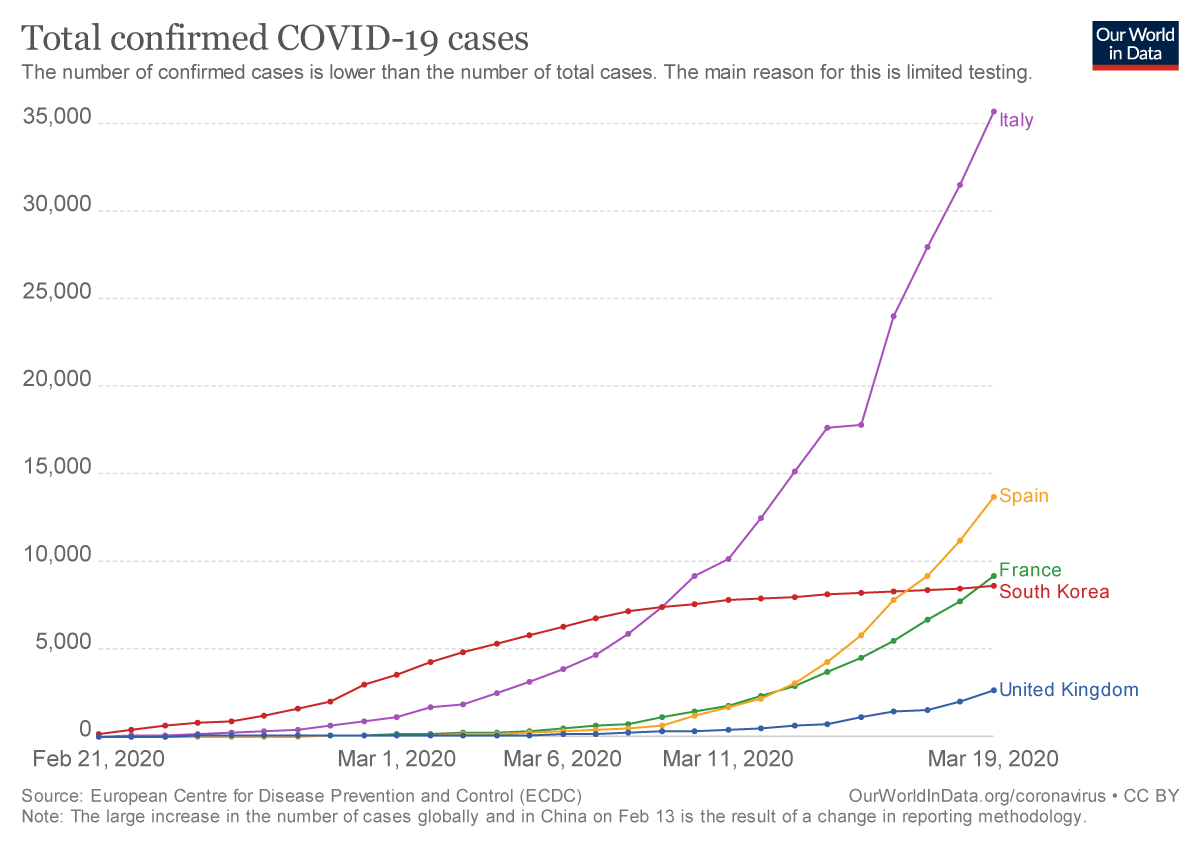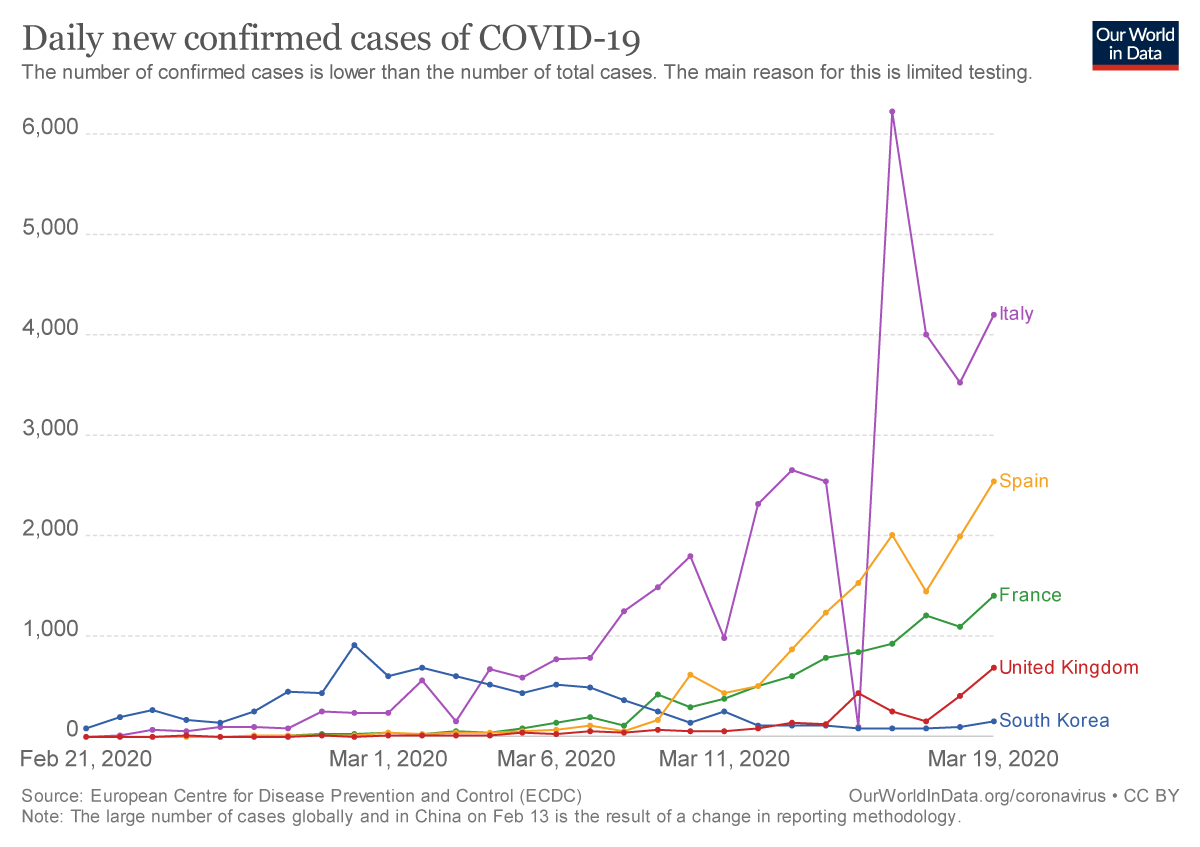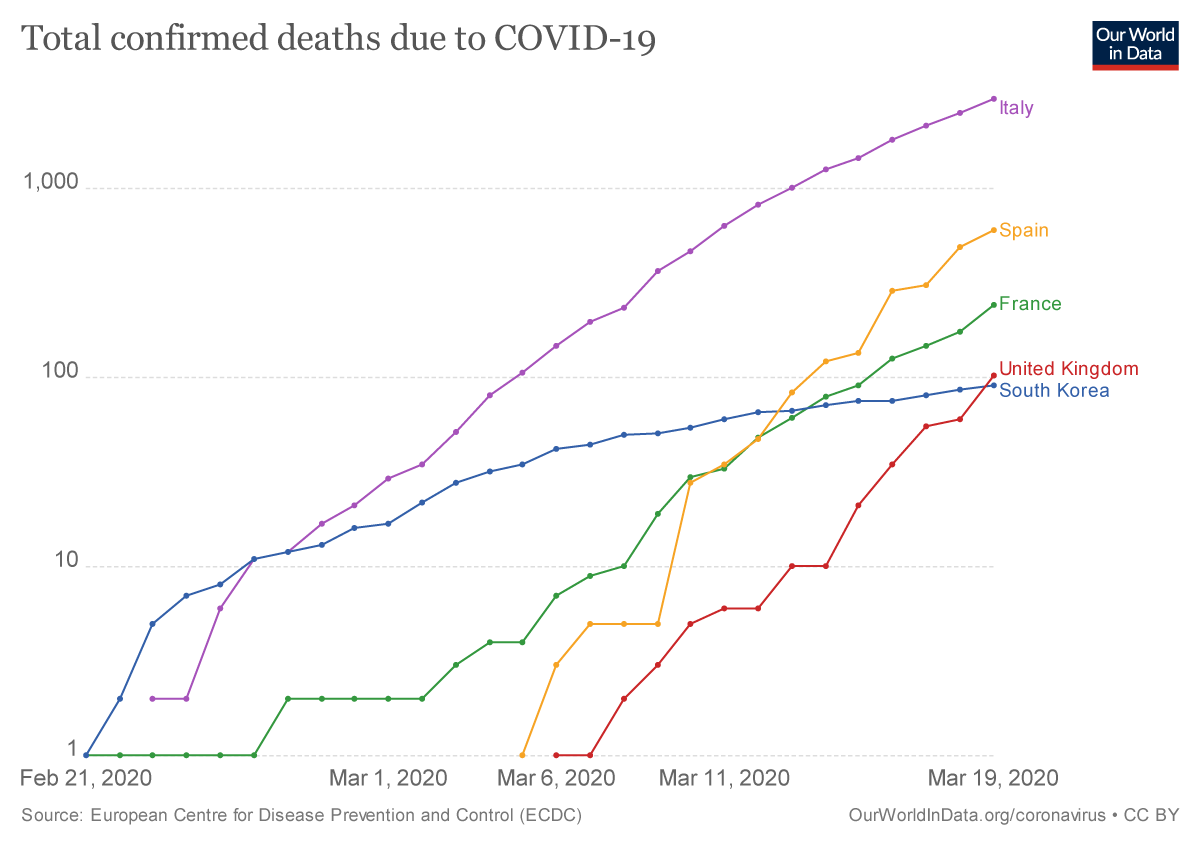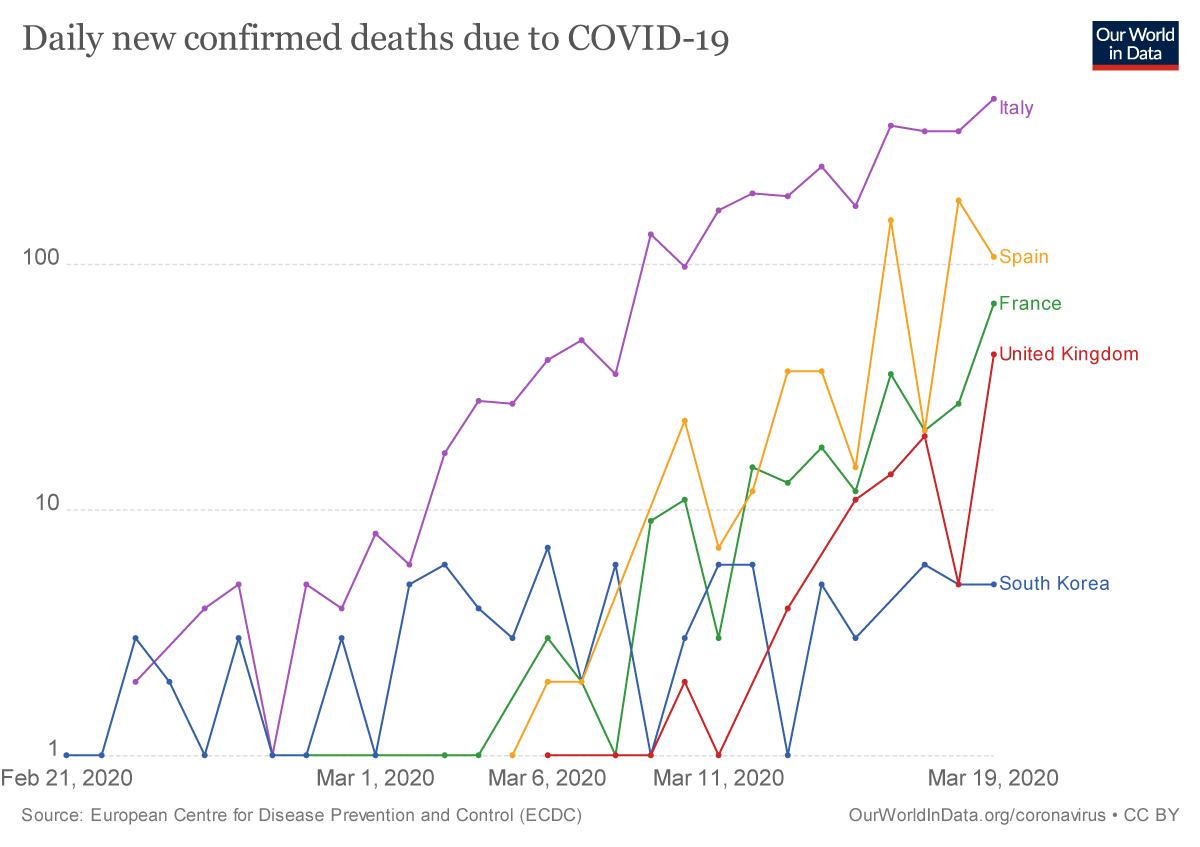S. Luchini, M. Degoulet, C. Baunez and P. Pintus, a team of researchers from Institut de Neuroscience de la Timone and Aix-Marseille School of Economics, propose a research program that assesses whether animals and humans are sensitive to acceleration/deceleration of harm and gains, in relation to the occurrence of rare and extreme events. Their program offers guidance towards designing a suitable approach to global pandemics like the COVID-19, from the perspective of both informing the population and guiding public decision-makers in designing public health policy. The main recommendation is to measure and monitor acceleration/deceleration of confirmed cases and deaths over health policy responses, across countries. Such an approach has the merit to provide an indicator of policy effectiveness in real time that is simple, transparent and easy to communicate about.
At the time this note is being written, the world is trying to cope with a quickly expanding pandemic related to COVID-19. The latter virus is a new strain of coronaviruses at the origin of an outbreak that started in China, possibly as early as November 17, 2019, when patient zero was supposedly contaminated. The World Health Organization was alerted on this outbreak on December 31 and the spread of the virus has since then gone global, to now reach 155 countries. Geographically though, it is not the case that all countries were exposed to COVID-19 at the same time. Obviously, populations in South-Asian countries that are close to China got contaminated earlier than, say, European citizens. This simple fact enables one to compare how the virus spread in different countries, which is the outcome of how people and public authorities have reacted. It is instructive, with such a mindset, to compare South Korea with France, Italy, Spain and the United Kingdom.
Figure 1 : Total and daily confirmed cases for each of the five countries.
The two panels in Figure 1 clearly show that while South Korea was able to curb the evolution of the pandemic very early on, European countries did not. Since the very beginning of the outbreak on January 20, 2020, South Korea implemented a very active strategy by testing about 290,000 people out of the 50-million population (that is, about 1 person in 200). In contrast, such a testing policy was not adopted in France, Italy and Spain, where the biggest step against the coronavirus was a lockdown of the country, as late as March 9 for Italy, March 16 in Spain, and March 17 in France. To this day, neither of such policies has been adopted in the UK.
Figure 1 - Panel (a)

Panel (a) in Figure 1 reveal that the acceleration of the total number of cases was stopped in South Korea about March 1st, that is, about a month after the start of the outbreak. At that time, the acceleration in Italy was already discernable.
This is confirmed in panel (b), which shows that the number of daily new cases peaked on March 1st in South Korea, whereas it had been trending up in Italy for some days. One week later, on March 8, acceleration was at an early stage but still visible in the data for France and Spain – see panel (a) in Figure 1. In Italy, the daily new number of cases was then close to the South Korean maximum and going up even faster.
Figure 1 - Panel (b)

It is difficult not to interpret Figure 1 as testifying to the fact that public authorities in charge of health policy in the four non-Asian countries were subject to some inertia in deciding how to curb the pandemic. More precisely, looking at Figure 1 suggests that Italy, Spain and France should have taken aggressive action against the coronavirus at least one week earlier that they effectively did. To the extent that the lockdown of the country is the right course of action, it should have been decided one week before it happened in all three countries.
Note that a similar conclusion is reached if one looks at the number of deaths, shown in Figure A1 of the Appendix.
The diagnostics about the evolution of the pandemic in Europe have been misled
The conclusion stated above implies that the diagnostics about the evolution of the pandemic in Europe have been misled, in view of European and South Korean data that were available in real time since mid-February. What we have in mind is that the total number of cases in South Korea in panel (a) of Figure 1 describes an accelerating (i.e. convex) curve over time before March 1st, and a decelerating (i.e. concave) curve after that date. Eventually, the number of cases seems to approach an upper limit, which indicates that the adopted policy is the right one.
That turn of event was observable when acceleration was in full swing in Europe, certainly on March 1st in Italy and one week later in Spain and France. This means that those three countries could have envisioned at that time that their exposure to the COVID-19 could possibly lead to a perpetuating acceleration of the number of cases and deaths over time if no strong action was taken. A possible alternative to lockdown policies was extended testing, which proved instrumental to curb the pandemic in South Korea. We conclude that both the general population and the public authorities in charge of health policy failed in the first week of March to make correct inferences from the fact that acceleration of harm was still happening in Europe, unchecked. In contrast, South Korea’s data was showing at the time that appropriate action could be taken to curb the pandemic.
Blindness to acceleration (that is, convexity) of harm is in general a major roadblock to decision-making and we briefly describe below a research program that aims to shed light on and offer remedy to the obstacles over which France, Italy, Spain - possibly the United Kingdom - seem to have tripped when assessing the dynamics of the global pandemic. We argue that getting closer to the best decision-making process in times when harm accelerates quickly in real time around the globe is to be able to detect as quickly as possible such an acceleration over policy responses, across countries. Only then is it possible to switch to a better exposure/technology that paves the way for deceleration of harm in the short run, thus putting a limit on maximum harm, by mimicking or adapting the best options available worldwide. To illustrate such an approach, consider Figure 2.
Figure 2 - Scatterplot of total confirmed cases and tests of the COVID-19 in South Korea.
In Figure 2 we report how the total number of confirmed cases responds to the total number of tested individuals in South Korea. Public health policy is arguably on the right track when such a response shows deceleration (i.e. concavity), which started on March 1st after acceleration came to a halt in South Korea. Looking at the data in this way would have probably been useful to decision-makers in Europe in early March. This is because acceleration/deceleration of harm is an important measure to guide public policy. Deceleration gives hope that harm will eventually level up, which is especially important when more harm means more human deaths.
Broadly speaking, the approach we advocate involves thinking less in terms of predictions in situations where it is very difficult to get precise estimates of probabilities and outcomes as uncertainty unfolds. Instead, the idea is to think it terms of exposure to uncertainty, following Taleb (2012)1. In the context of real-time observation of ongoing pandemics, this means that one should gather all possible data to assess whether and where harm accelerates over time and, most importantly, as a function of the policy response. In contrast, countries or regions where the exposure to harm is concave (possibly following a period in which it was convex) as a function of policy are supposed to have adopted the best practices, the ones to follow or adapt. This is the case of South Korea, as shown in Figure 2. In sum, we argue that a suitable approach to global pandemics like the COVID-19 is, from the perspective of both the general population and public decision-makers, to measure and monitor acceleration/deceleration of confirmed cases and deaths over policy responses, across countries. Such an approach has the merit to provide an indicator of policy effectiveness in real time, that is simple, transparent and easy to communicate about in the context of public health policy design.2
The difficulty with the case at hand is that the information in Figure 1, though necessary, is not enough to inform the population and to guide policy makers. What is needed is to measure how harm (number of cases and of deaths) responds to policy, and whether it decelerates and eventually stays bounded below some upper bound. Figure 2 illustrates that type of key information. In addition, it is imperative to have internationally comparable measures across countries. The fact that such deceleration/concavity measures seem not to be part of the data dashboards of governments around the world possibly relates to preliminary results from ongoing experiments using animal and human subjects that we are currently conducting. In a forthcoming paper3, we report preliminary results showing that rats are sensitive to acceleration/convexity of gains and deceleration/concavity of losses, when confronted with options that differ along this dimension. However, such sensitivity is heterogeneous across animal subjects, which suggests that detecting acceleration/deceleration may not be natural for all individuals. Heterogeneity is confirmed by preliminary results from ongoing experiments with human subjects, whose sensitivity to acceleration/deceleration is however hampered by uncertainty. Our preliminary results therefore suggest that if at the individual level sensitivity to acceleration/convexity does not always manifest itself, the question is whether we can find sensitivity measures and policy responses at the collective level, such as the one sketched in Figure 2. In other words, how can we collectively ensure that society gets rid of accelerating harm?
Corresponding authors: stephane.luchini@univ-amu.fr, patrick.pintus@univ-amu.fr
- 1. Taleb, N. (2012). «Antifragile, things that gain from disorder». Random House.
- 2. As will become clear later, our approach is potentially useful to study acceleration of harm in other areas, including biodiversity or climate change. Symmetrically, detecting acceleration of gains due to better and more useful knowledge should be relevant for decisions to fund public and private research.
- 3. Degoulet, Willem, Baunez, Luchini, Pintus: “Sensitivity to Rare and Extreme Events in Rats: the Black-Swan-Avoidance Bias”, march 2020, forthcoming bioRΧiv and Aix-Marseille School of Economics working paper.
Appendix :
Panel (a) of Figure A1 below shows that while France, Italy, Spain and the UK experience exponential growth of deaths over time (remember log scale), this is not the case of South Korea. Moreover, it was visible on March 1st that South Korea had been able to curb the number of fatalities. From Panel (b) of Figure A1, we see that all countries expect South Korea have daily new deaths trending up over time.
Figure A1 - Panel (a)

Figure A1 - Panel (b)







